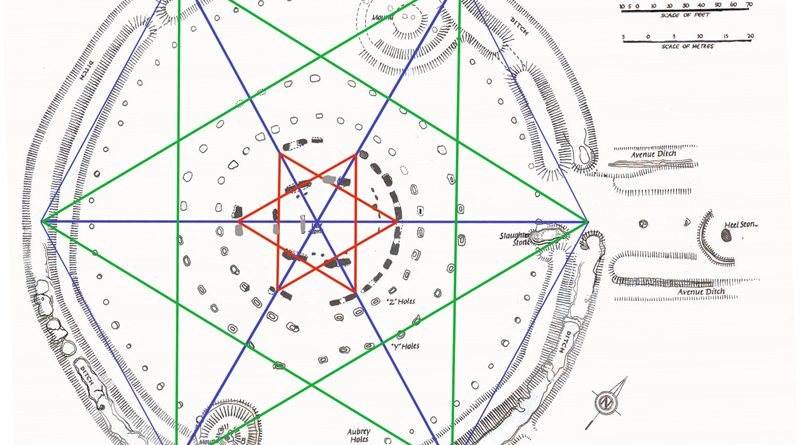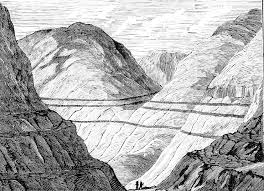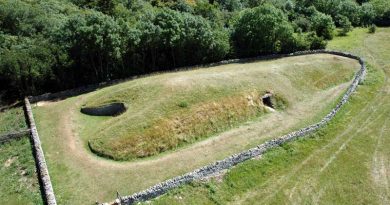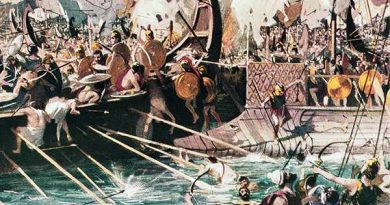Quantum of Solstice – Stonehenge’s Pythagorean triangles used four thousand years before he was born
If an elderly but distinguished scientist says that something is possible, he is almost certainly right; but if he says that it is impossible, he is very probably wrong – Arthur C. Clarke
Suppose we look at the skills of what traditional archaeologists call the ‘Megalithic People’ – the civilisation that made the first stone monuments. We notice that to achieve such grand constructions, they would have required advanced mathematics, which to date have been credited to the ancient Greeks.
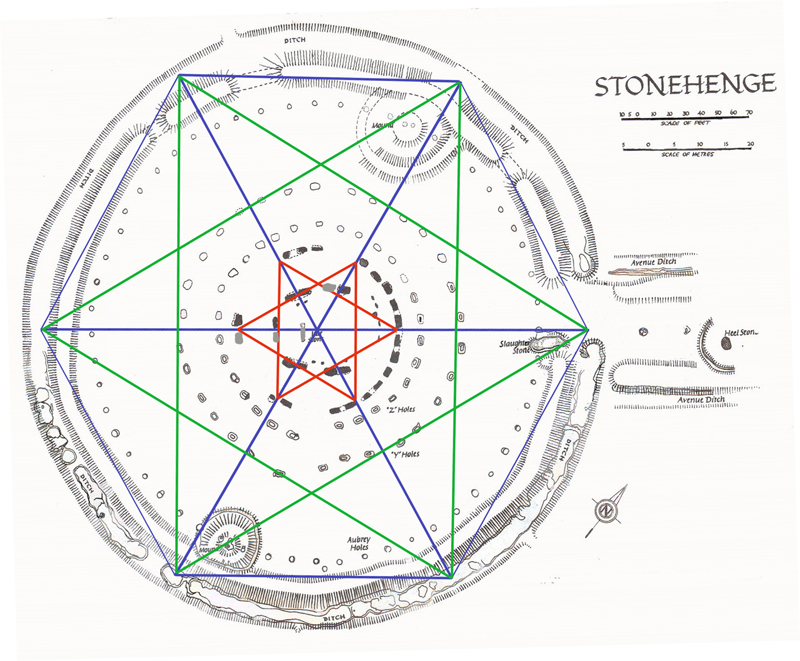
By undertaking a closer detailed analysis of monuments such as Stonehenge and, more importantly, the mathematics used to design such monuments, we can see that these constructions, which are ten thousand years old, were based on sound and accurate trigonometrical theory.
How was Stonehenge planned, and what can we see from the ‘blueprint’ what they knew about mathematics?
The Stonehenge Blueprint
Firstly, Stonehenge was built in two very separate phases – current archaeologists are confused by the monument and dating of the structure, so if you read or browse the internet, you will see the ‘traditionalist’ quote three to five phases. Moreover, these phases occurred AFTER the original monument was abandoned, and thousands of years later, the ritualistic Celts occupied the monument and used it to worship the Sun and the Summer Solstice as we see re-enacted today during the summer solstice.
The First Phase took place at 8500 BCE when our ancestors built the original ditch created of individual pits that were cut below the ancient groundwater table level to create a moat. This moat was used with the Bluestones to bathe away infections from cuts and bites, which would have turned into gangrene and lethal fevers if left untreated. Bluestones (when wet) releases chemicals, including the most potential natural antiseptic – rock salt.
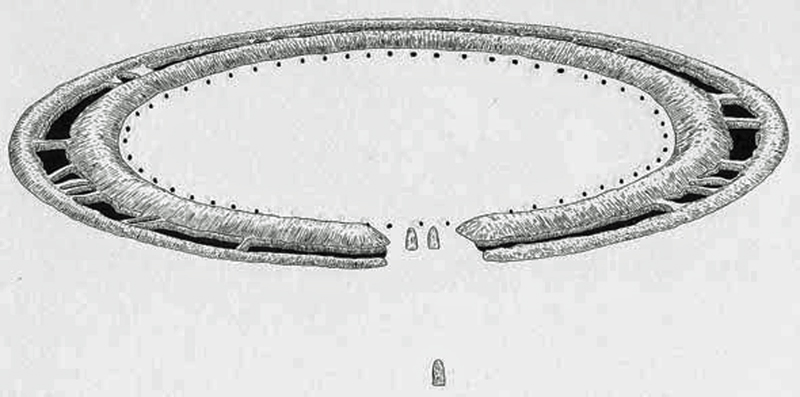
The most remarkable aspect is the accuracy of the diameter of this moat, which is precisely 360 ft (109.73m). This length is no accident or coincidence; it is the reason that our angular and trigonometrical system revolves around 360!
We have 12 months a year, and each has a lunar cycle that lasts (from New Moon to New moon) 29.53 days. There were 56 Bluestones (2 x 28), and we can show that this was used as a very accurate (99.8%) moon and eclipse calendar, which could compensate for the 0.47-day difference between the moon cycle and a 30-day standard cycle. It is, therefore, no surprise that the most ancient of calendars are 12 x 30 = 360 days in length.
In history, we know that civilisations worldwide either discarded or modified their old 360-day calendars. The 360-day calendars had been used for the more significant part of the past millenniums. In many places, month lengths immediately after that change were not fixed but based on observing the sky.
Priest-astronomers were assigned to declare when a new month began – it was usually said to have started at the first sighting of a new moon. Month length at that time was simply the number of days that passed from one new lunar crescent to the next. For example, during those years in Rome, a Pontifex (priest) observed the sky and announced a new moon and, therefore, the new month to the king. For centuries afterwards, Romans referred to the first day of each new month as Kalends or Kalends from their word calare (to announce solemnly, call out). The word calendar is derived from this custom.
The ancient Babylonians in 4000 BCE used a calendar with alternating 29-day and 30-day months. This system required the addition of an extra month three times every eight years, and as a further adjustment, the king would periodically order the insertion of an extra month into the calendar.
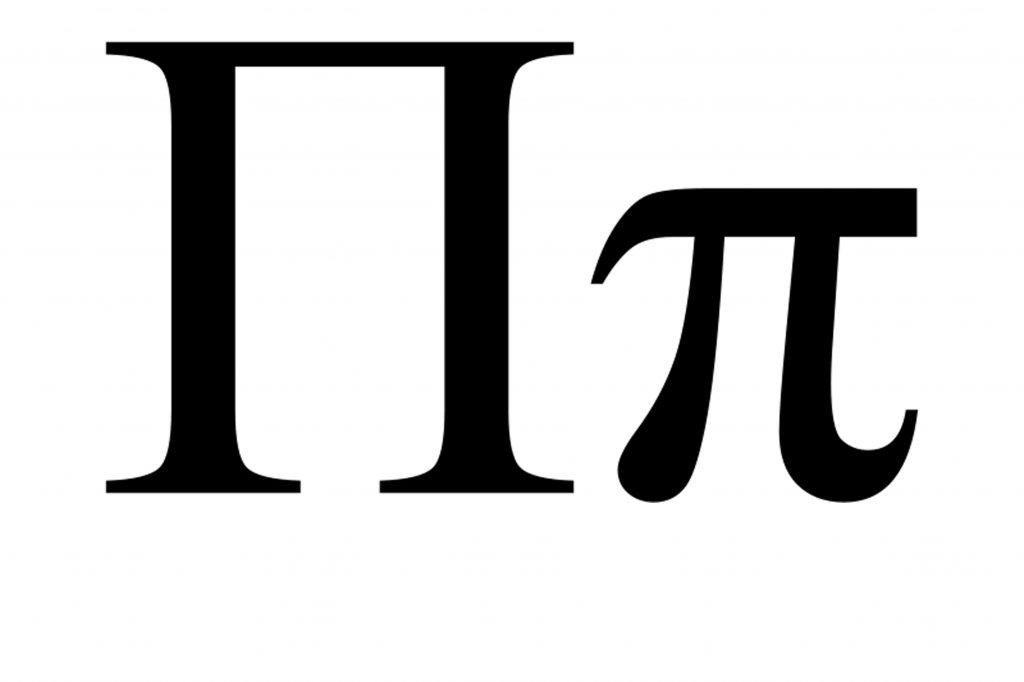
However, it is interesting that the monument becomes a ‘time capsule’ from our ancestors to show us that they understood the mysteries of mathematics. When a circle, a diameter of 360 ft has a moated circumference (the area around the edge of the circle) of 1130 ft in length. So if we divide the measurement around the edge 1130 by the diameter 360, we get a fascinating number 3.14 – why is this absorbing, because it’s what we know as PI or 3.14159….
Did the builders of Stonehenge leave us a message in stone?
No one knows who invented Pi, yet the Ancient Greeks used this unusual symbol to denote pi – does it remind you of some monument we have discussed? Furthermore, why would the Greeks use such a symbol to represent the relationship of a circle to its diameter? Indeed, you would use something round, not a classic trilithon symbol as found at Stonehenge – unless, of course, that’s where it was first used?
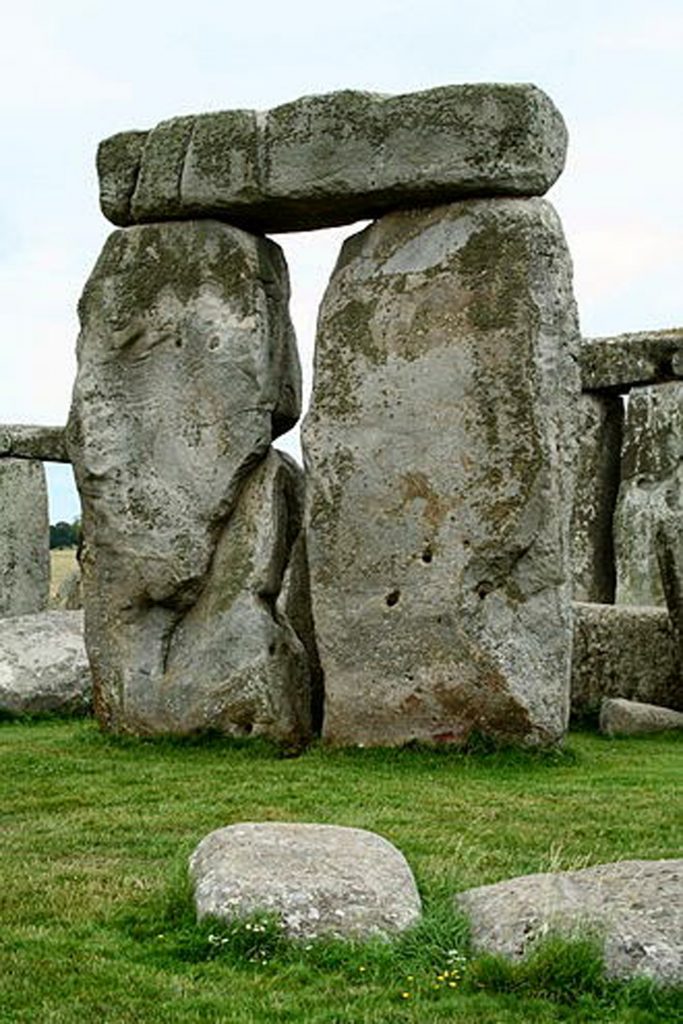
Now 360 is also an exciting number for circles as there are 360 degrees in a circle. This is a particular number, for if you were to pick a standard number to determine the degrees in a circle, would you not go for something much more manageable and obvious to remember and use, like 100?
Such a number is not suitable for trigonometry as a standard right-angle triangle with a 360-degree circle has 90 – 60- 30, which allows simple mental maths to be calculated, such as calculating the sides of a triangle. For if it were based on a 100-degree circle, the triangle angles would be 25 – 16.66 – 8.33, and the ability to calculate angles in your head or as an approximation (no electronic calculators in the Stone Age) be far more complex.
The logic to link the degrees (or days) in a circle or solar year is evident and is reflected in man’s first stone construction at Stonehenge. However, Pi is only the start of this amazing construction, and the work accredited to Pythagoras in the past must now be questioned.
Phase II Construction
Four thousand years after, the original Phase I Circle was constructed with the 58 Aubrey Holes that held Bluestones from the Preseli Mountains in Wales. These stones were used for mapping the 360-day lunar calendar; they decided to erect an additional central monument.
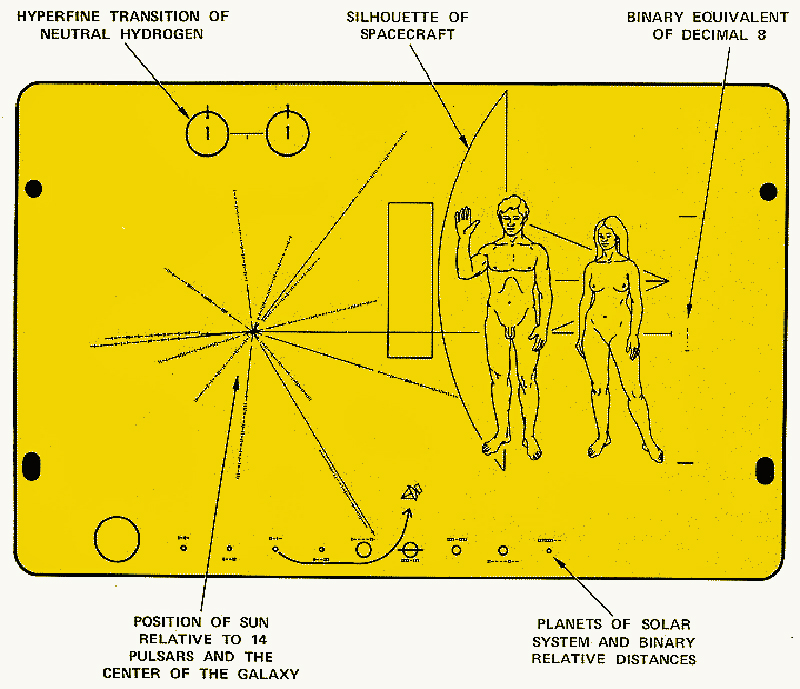
In the second book of the Prehistoric Trilogy: ‘The Stonehenge Enigma’ – I proved that this monument was a temple to the dead of Doggerland, who died in an earthquake and subsequent tsunami in about 4200 BCE as recorded within Plato’s dialogues. Like a relief map of Doggerland (Slaughter Stone) and the Altar Stone (both are the only two deliberate recumbent stones) directly point to the ancient island and was included at the time of construction.
Phase II of this construction included a new entrance causeway surrounded by moats known today as ‘The Avenue’, which led to the Neolithic shoreline in the dry river valley at Stonehenge Bottom. This 600 m’ road’ was used to, not only, transport people to the monument, but moreover, to move the larger Sarsen stones (weighing up to 16 tonnes) by boat to the new monument at Stonehenge from the Marlborough Downs near Avebury a distance of between 20 – 25 miles.
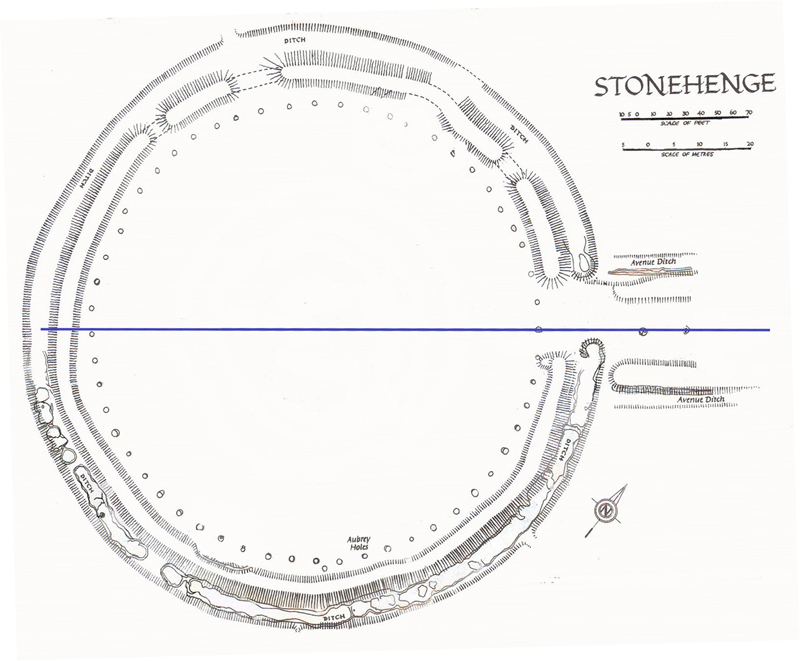
However, rather than just building any road to the shoreline, they decided to make it on an alignment that marks the Summer Solstice’s longest day. This day was significant for our ancestors as it corrects the 360-day lunar calendar with the solar calendar, which is five days longer (365 days which we use today). So they placed two stones in the centre of The Avenue (which are now missing) in exact alignment to the sunrise when we first constructed this monument.
This alignment gives us the ‘best’ date for the construction of Stonehenge (as carbon dating is not possible for stones or stone holes) and confirms the date of Doggerland demise in 4200BCE.
We have now our first ‘chord’ alignment that corresponds to the diameter of the Stonehenge ditch and the starting point of the circle, which is its alignment to The Avenue.
From this start, they then sub-divided the circle up into six portions called a ‘Hexagram’ in mathematical terms for as we will show you in the book ‘Dawn of the Lost Civilisation’, the number six and its multiples are significant to our ancestors.
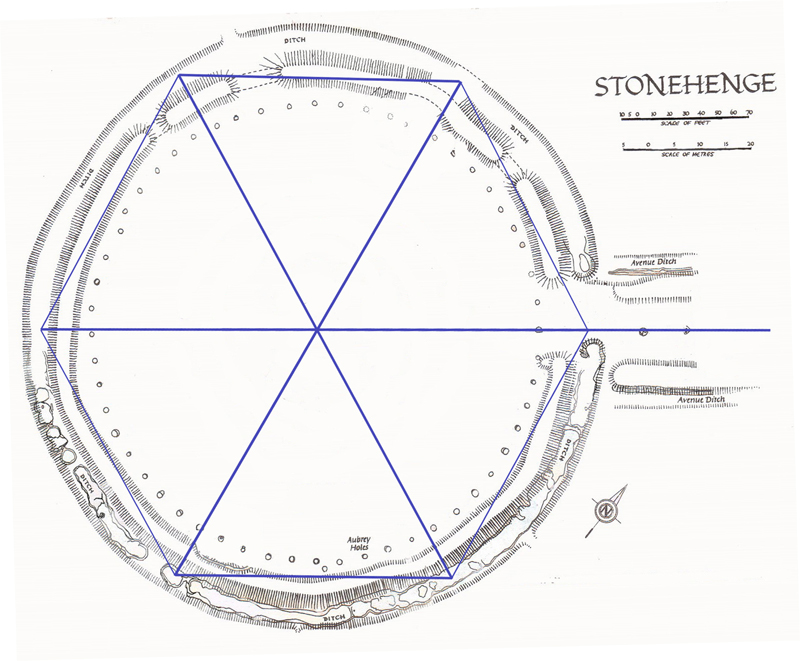
The Hexagram was constructed by a series of strings of the same length (centre of the monument to the ditch), creating six ‘equilateral’ triangles, with all three sides the same length, and therefore all three angles are of 60 degrees.
A crescent of stones was then formed for the monument for the temple was dedicated to the dead and, therefore, would have represented the crescent moon, NOT the Sun as some currently believe, for this adaptation occurred when later Druids altered the site by adding smaller stones and re-positioning the outer circle of bluestones.
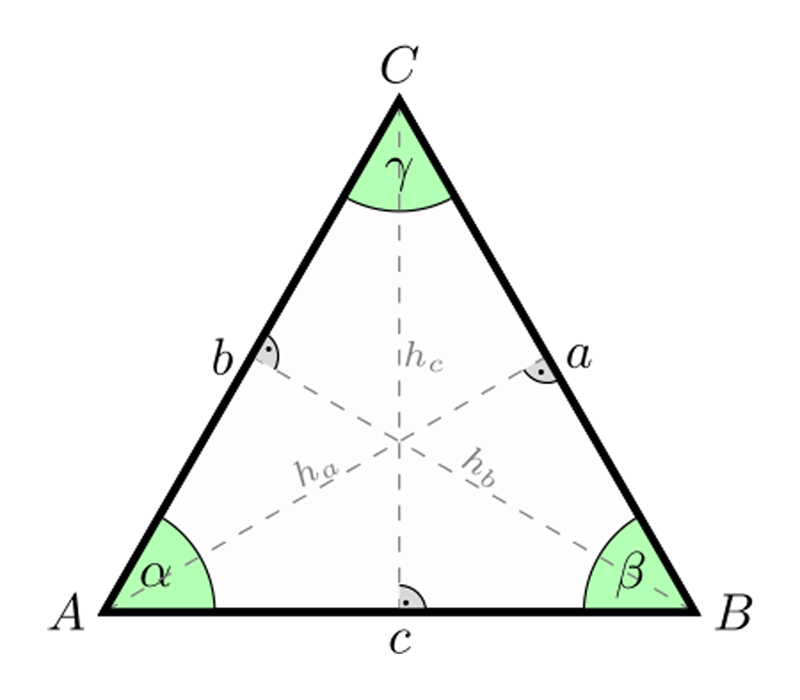
Then the five pairs of the trilithon stones in the inner horseshoe were added, making sure the gaps between the stones followed the alignment corresponded to the hexagram design. Lastly, the smaller outer circle trilithon aligned with the winter solstice sunset was added to complete the monument.

The Hexagram is a mandala symbol called satkona yantra or sadkona yantra found on ancient South Indian Hindu temples. It symbolises the nara-narayana, or perfect meditative state of balance achieved between Man and God, and if maintained, results in “moksha,” or “nirvana” (release from the bounds of the earthly world and its material trappings).
Is this what we see in the construction of Stonehenge – humanity’s first religious beliefs of ‘Man’ the bottom triangle pointing up and God or Spirit world the triangle pointing or looking down?
We know about Stonehenge that it was a temple to the dead of Doggerland constructed at the same time that Doggerland was swamped by the rising sea levels we are still experiencing today. This disappearing peninsula started to erode some ten thousand years ago, directly after the last Ice Age had ended and the seas began to rise, which over the next six thousand years left this once mighty land as a small island Plato called Atlantis.
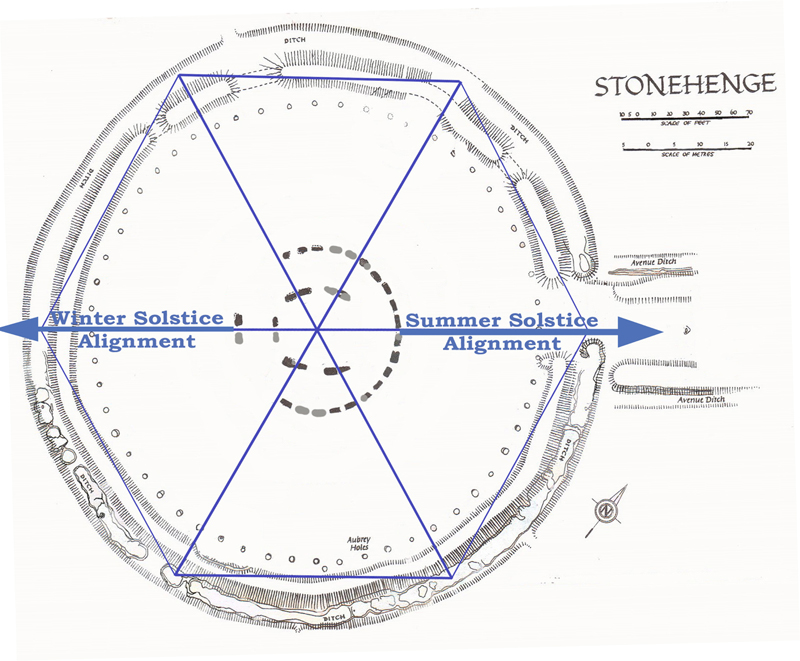
Why is a foot 12 inches, and what is the unit of measurement to do with the builders of Stonehenge?
Another ‘Thing that doesn’t make sense in History’ is the ‘Foot’. We call it an ‘imperial unit measurement.’ But where does it originate?
Wikipedia will tell you:
Historically the foot, which was used in Ancient Greece, Ancient Rome, England, Scotland and many Continental European countries and which varied from country to country and in some cases from city to city, was part local systems of units. Its length was usually between 250 mm and 335 mm and was generally, but not always, subdivided into 12 inches or 16 digits.
We know it’s old, but we have no idea who invented it or why they split the unit into 12 or 16 inches or digits. As we have already stated, the Stonehenge moat is 360 feet wide, and we have shown that it was constructed by a system of simple strings in a hexagon pattern.

For more information about British Prehistory and other articles/books, go to our BLOG WEBSITE for daily updates or our VIDEO CHANNEL for interactive media and documentaries. The TRILOGY of books that ‘changed history’ can be found with chapter extracts at DAWN OF THE LOST CIVILISATION, THE STONEHENGE ENIGMA and THE POST-GLACIAL FLOODING HYPOTHESIS. Other associated books are also available such as 13 THINGS THAT DON’T MAKE SENSE IN HISTORY and other ‘short’ budget priced books can be found on our AUTHOR SITE. For active discussion on the findings of the TRILOGY and recent LiDAR investigations that is published on our WEBSITE you can join our FACEBOOK GROUP.

